(完整版)苏教版译林牛津初中英语语法总结(初一初二)
(完整版)译林牛津七年级下学期英语语法总结
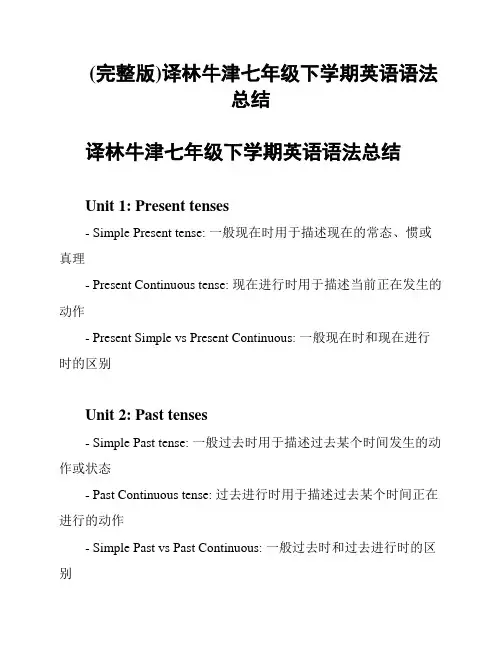
(完整版)译林牛津七年级下学期英语语法总结译林牛津七年级下学期英语语法总结Unit 1: Present tenses- Simple Present tense: 一般现在时用于描述现在的常态、惯或真理- Present Continuous tense: 现在进行时用于描述当前正在发生的动作- Present Simple vs Present Continuous: 一般现在时和现在进行时的区别Unit 2: Past tenses- Simple Past tense: 一般过去时用于描述过去某个时间发生的动作或状态- Past Continuous tense: 过去进行时用于描述过去某个时间正在进行的动作- Simple Past vs Past Continuous: 一般过去时和过去进行时的区别Unit 3: Future tenses- Will + verb: 表示将来的决定、打算或预测- Be going to + verb: 表示计划、意图或预测- Future Continuous tense: 将来进行时用于描述将来某个时间正在进行的动作- Future Simple vs Be going to: 将来时的两种表达方式的区别Unit 4: Passive voice- Active voice vs Passive voice: 主动语态和被动语态的区别- How to form the passive voice: 构成被动语态的方法- Passive voice with different tenses: 不同时态的被动语态形式Unit 5: Modal verbs- Can, could, may, might: 表示能力、允许或可能性- Must, have to: 表示必须、责任或推测- Should, ought to: 表示应该、建议或期望Unit 6: Conditionals- Zero conditional: 表示真理、自然法则或普遍情况- First conditional: 表示可能性、条件或可能的反应- Second conditional: 表示假设、不太可能的情况或对应的行动- Third conditional: 表示虚构、过去的假设或悔恨Unit 7: Reported speech- Reporting verbs: 常用的引述动词- Reporting statements: 直接引述陈述句的变化- Reporting questions: 直接引述疑问句的变化以上是译林牛津七年级下学期英语语法总结的内容。
译林牛津七年级上学期英语语法知识总结
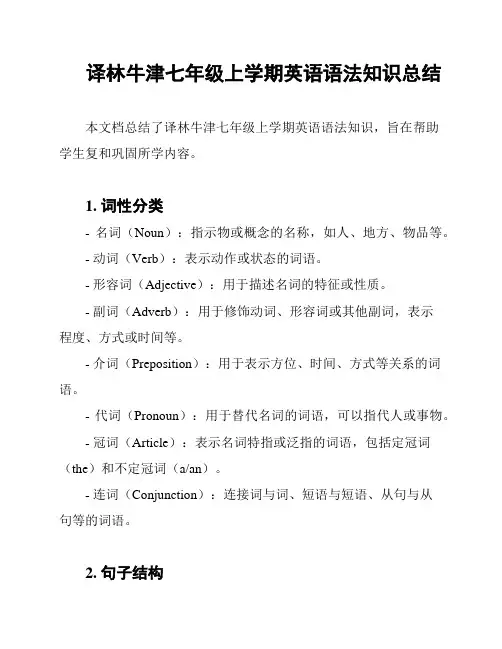
译林牛津七年级上学期英语语法知识总结本文档总结了译林牛津七年级上学期英语语法知识,旨在帮助学生复和巩固所学内容。
1. 词性分类- 名词(Noun):指示物或概念的名称,如人、地方、物品等。
- 动词(Verb):表示动作或状态的词语。
- 形容词(Adjective):用于描述名词的特征或性质。
- 副词(Adverb):用于修饰动词、形容词或其他副词,表示程度、方式或时间等。
- 介词(Preposition):用于表示方位、时间、方式等关系的词语。
- 代词(Pronoun):用于替代名词的词语,可以指代人或事物。
- 冠词(Article):表示名词特指或泛指的词语,包括定冠词(the)和不定冠词(a/an)。
- 连词(Conjunction):连接词与词、短语与短语、从句与从句等的词语。
2. 句子结构- 主语(Subject):句子中进行动作或被描述的人、事物或概念。
- 谓语(Predicate):句子中表达动作或状态的部分,通常是动词。
- 宾语(Object):动作的承受者或受益者,是动词的补充部分。
- 定语(Attributive):用于修饰名词或代词的形容词、副词等。
- 状语(Adverbial):修饰动词或整个句子的副词、介词短语等。
3. 时态与语态- 时态(Tense):表示动作发生的时间,如一般现在时、过去时、将来时等。
- 语态(Voice):表示动作的主体和动作所受的影响关系,如主动语态和被动语态。
4. 句型结构- 简单句(Simple Sentence):只包含一个主语和一个谓语的句子。
- 并列句(Coordination Sentence):由并列连词连接的两个或多个简单句。
- 疑问句(Question Sentence):用于提问的句子,通常以疑问词开头或动词倒装。
以上是关于译林牛津七年级上学期英语语法知识的简要总结。
希望这份文档能够帮助你更好地复习和应用所学的语法知识。
祝你学习进步!。
初中英语苏教版知识点总结
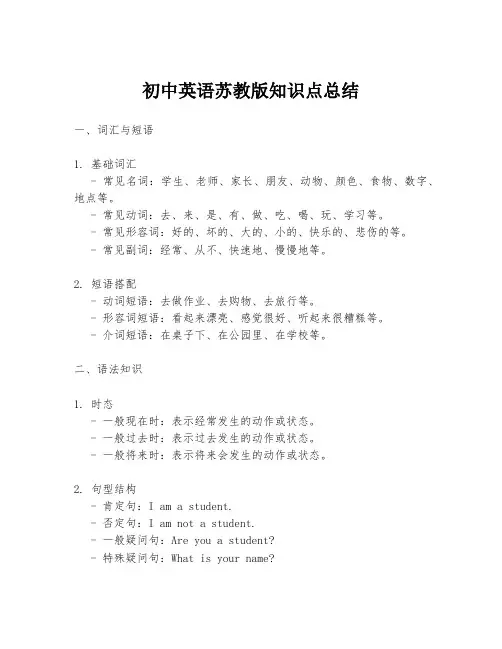
初中英语苏教版知识点总结一、词汇与短语1. 基础词汇- 常见名词:学生、老师、家长、朋友、动物、颜色、食物、数字、地点等。
- 常见动词:去、来、是、有、做、吃、喝、玩、学习等。
- 常见形容词:好的、坏的、大的、小的、快乐的、悲伤的等。
- 常见副词:经常、从不、快速地、慢慢地等。
2. 短语搭配- 动词短语:去做作业、去购物、去旅行等。
- 形容词短语:看起来漂亮、感觉很好、听起来很糟糕等。
- 介词短语:在桌子下、在公园里、在学校等。
二、语法知识1. 时态- 一般现在时:表示经常发生的动作或状态。
- 一般过去时:表示过去发生的动作或状态。
- 一般将来时:表示将来会发生的动作或状态。
2. 句型结构- 肯定句:I am a student.- 否定句:I am not a student.- 一般疑问句:Are you a student?- 特殊疑问句:What is your name?3. 代词- 人称代词:I, you, he, she, it, we, they.- 物主代词:my, your, his, her, its, our, their.- 反身代词:myself, yourself, himself, herself, itself, ourselves, yourselves, themselves.4. 冠词- 不定冠词:a, an.- 定冠词:the.5. 介词- 表示时间:at, on, in.- 表示地点:at, on, in, under, above, behind.- 表示方向:to, towards, through.6. 连词- 并列连词:and, but, or, so.- 从属连词:because, since, although, if, when, while.三、阅读理解1. 文章类型- 记叙文:讲述人物、事件的故事。
- 说明文:解释事物的特性、原因、过程等。
初中英语语法(苏教版)教材语法目录
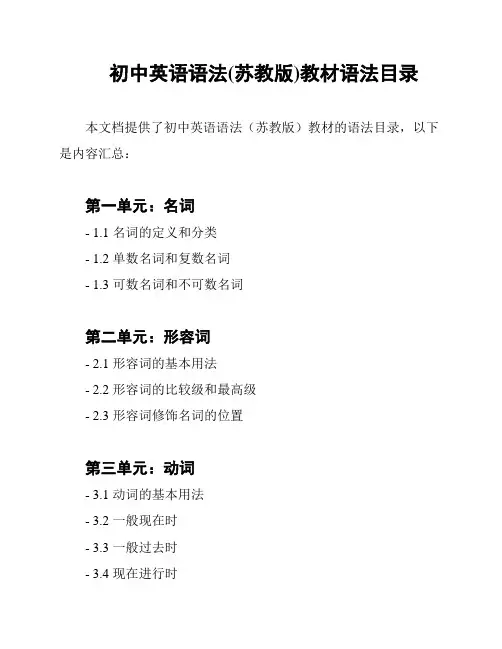
初中英语语法(苏教版)教材语法目录
本文档提供了初中英语语法(苏教版)教材的语法目录,以下是内容汇总:
第一单元:名词
- 1.1 名词的定义和分类
- 1.2 单数名词和复数名词
- 1.3 可数名词和不可数名词
第二单元:形容词
- 2.1 形容词的基本用法
- 2.2 形容词的比较级和最高级
- 2.3 形容词修饰名词的位置
第三单元:动词
- 3.1 动词的基本用法
- 3.2 一般现在时
- 3.3 一般过去时
- 3.4 现在进行时
- 3.5 一般将来时
第四单元:副词
- 4.1 副词的基本用法
- 4.2 表示时间的副词
- 4.3 表示地点的副词
- 4.4 表示方式的副词
第五单元:代词
- 5.1 人称代词的基本用法- 5.2 物主代词的基本用法- 5.3 反身代词的基本用法
第六单元:介词
- 6.1 介词的基本用法
- 6.2 表示位置的介词
- 6.3 表示时间的介词
- 6.4 表示方式的介词
第七单元:连词
- 7.1 连词的基本用法
- 7.2 并列连词
- 7.3 选择连词
- 7.4 原因连词
第八单元:句子结构
- 8.1 简单句的基本结构
- 8.2 并列句的结构
- 8.3 复合句的结构
以上是初中英语语法(苏教版)教材的部分语法目录。
这些内容将帮助学习者掌握基本的英语语法知识,为之后的学习打下坚实的基础。
最新苏教版(译林版)初中英语各册单元语法点复习梳理
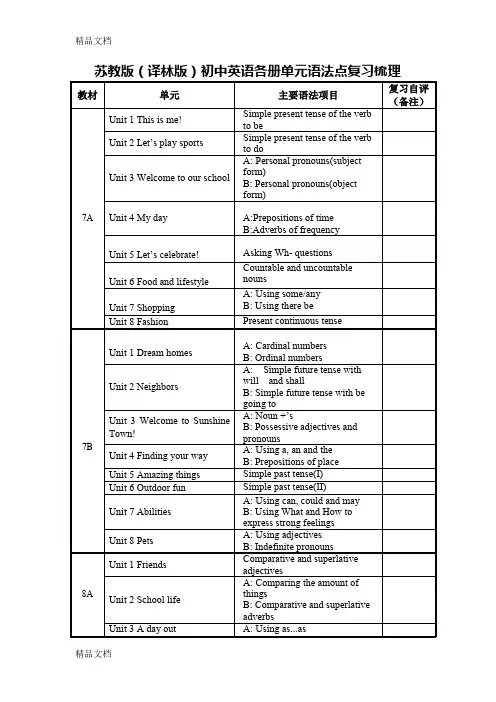
Unit 6Birdwatching
A: Using to-infinitive for purpose
B: Using verbs+ to-infinitives
Unit 7Seasons
Verbs and sentence structures
Unit 8Natural disasters
A: Past continuous tense
B: Using when,while and as
8B
Unit 1Past and present
Present perfect tense
Unit 2Travelling
A: Using have/has been and have/has gone
B: Possessive adjectives and pronouns
Unit 4Finding your way
A: Using a, an and the
B: Prepositions of place
Unit 5Amazing things
Simple past tense(I)
Unit 6Outdoor fun
B:Adverbs of frequency
“碧芝”隶属于加拿大的beadworks公司。这家公司原先从事首饰加工业,自助首饰的风行也自西方,随着人工饰品的欣欣向荣,自制饰品越来越受到了人们的认同。1996年'碧芝自制饰品店'在迪美购物中心开张,这里地理位置十分优越,交通四八达,由于是市中心,汇集了来自各地的游客和时尚人群,不用担心客流量问题。迪美有300多家商铺,不包括柜台,现在这个商铺的位置还是比较合适的,位于中心地带,左边出口的自动扶梯直接通向地面,从正对着的旋转式楼拾阶而上就是人民广场中央,周边4、5条地下通道都交汇于此,从自家店铺门口经过的90%的顾客会因为好奇而进看一下。Unit 5Let’s celebrate!
初一初二英语语法知识点归纳总结
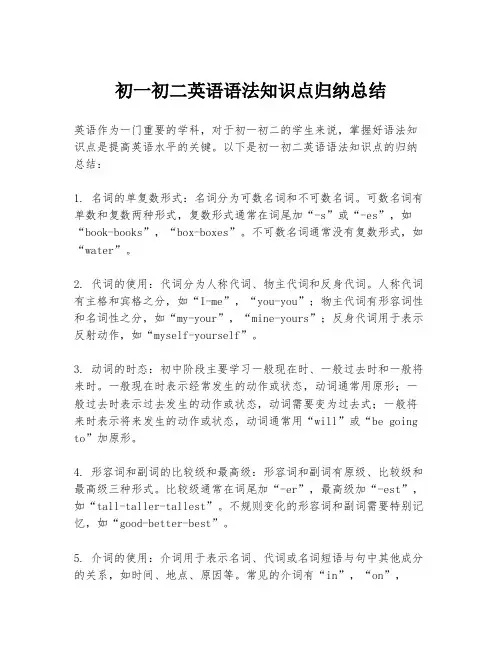
初一初二英语语法知识点归纳总结英语作为一门重要的学科,对于初一初二的学生来说,掌握好语法知识点是提高英语水平的关键。
以下是初一初二英语语法知识点的归纳总结:1. 名词的单复数形式:名词分为可数名词和不可数名词。
可数名词有单数和复数两种形式,复数形式通常在词尾加“-s”或“-es”,如“book-books”,“box-boxes”。
不可数名词通常没有复数形式,如“water”。
2. 代词的使用:代词分为人称代词、物主代词和反身代词。
人称代词有主格和宾格之分,如“I-me”,“you-you”;物主代词有形容词性和名词性之分,如“my-your”,“mine-yours”;反身代词用于表示反射动作,如“myself-yourself”。
3. 动词的时态:初中阶段主要学习一般现在时、一般过去时和一般将来时。
一般现在时表示经常发生的动作或状态,动词通常用原形;一般过去时表示过去发生的动作或状态,动词需要变为过去式;一般将来时表示将来发生的动作或状态,动词通常用“will”或“be goi ng to”加原形。
4. 形容词和副词的比较级和最高级:形容词和副词有原级、比较级和最高级三种形式。
比较级通常在词尾加“-er”,最高级加“-est”,如“tall-taller-tallest”。
不规则变化的形容词和副词需要特别记忆,如“good-better-best”。
5. 介词的使用:介词用于表示名词、代词或名词短语与句中其他成分的关系,如时间、地点、原因等。
常见的介词有“in”,“on”,“at”,“with”,“for”等。
介词的用法需要结合具体语境来掌握。
6. 连词的运用:连词用于连接词、短语或句子,表示并列、选择、转折等关系。
常见的连词有“and”,“but”,“or”,“so”,“because”等。
使用连词时要注意句子的逻辑关系。
7. 句子结构:英语句子的基本结构为主语+谓语+宾语,但根据需要可以加入定语、状语等修饰成分。
苏教版译林牛津重点初中英语语法总结归纳(初一初二
补充:1.句子的构成初中一年级上语法1.in,on,at表示时间的应用in +parts of day(evening,morning,etc) /month/season/yearon + day (Sunday, etc)/date(1 July,etc)/parts of a special day( Sunday morning)/special holidays(Children’sDay)at + time of day (seven o’clock)/ age(6 years old)2.频率副词1.比较级、最高级的用法than作为比较级、the+最高级的用法+er 及+est 的用法,most+形容词表示最高级2. more…than, fewer….than,less..than, the most, the fewest, the least的用法3. as…as的用法4.反身代词的用法Myself, yourself, himself, herself, itself, ourselves, yourselves, themselves5.祈使句的用法肯定:Open the door.否定:Don’t close the window.礼貌些:Please….6.表示建议should和had better的用法7.may来表示可能性的用法(区别初一下7,may作为询问语气的用法)8.不定式用法9.用不定式表示目的,用in order to表示目的10. A.“动词+宾语+不定式”结构,即,动词+宾语+to do(不定式)可用这类结构的常用动词有?advise, allow, ask, bear, beg, bother, cause, command, determine, encourage, expect, forbid, force, get, hate, help, intend, invite, leave, like, mean, need, order, permit, persuade, prefer, request, remind, request, teach, tell, trouble, want, warn, wish等。
苏教版译林版初中英语各年级知识点
Unit3Teenage problems
Unit4Growing up
Unit5Art world
Unit6TV programmes
Unit7Films
Unit8Detective stories[侦探小说]
9B
Unit1Asia
Unit2Great people
Unit3Robots
Unit4Life on Mars
7A
1动词be的一般现在时
2行为动词的一般现在时
3人称代词
4表示时间的介词
5频度副词
6特殊疑问句
7可数名词和不可数名词
8用some和any表示数量
9 there beபைடு நூலகம்构
10 现在进行时
7B
1 基数词
2 序数词
3 一般将来时(will shall)
4 一般将来时(be going to)
4 一般过去时和过去进行时
5 一般过去时和现在完成时
6 简单句和复合句之间的转换(一)
7 简单句和复合句之间的转换(二)
苏教版译林版初中英语各年级知识点(总4页)
7A
Unit1This is me!
Unit2Let’s play sports!
Unit3Welcome to our school!
Unit4My day
Unit5Let’s celebrate!
Unit6Food and lifestyles
Unit7Shopping
Unit2Travelling
Unit3Online tours
Unit4A good read
Unit5Good manners[彬彬有礼]
苏教版译林版初中英语各年级知识点
苏教版译林版初中英语各年级知识点Unit 1-8: These are the names of the units in a textbook or course.This is me。
- This unit is about XXX.Let's play sports。
- This unit is about different types of sports and physical activities.e to our school。
- This unit is about describing a school and its facilities.My day - This unit is about daily routines and activities.Let's celebrate。
- This unit is about different types of XXX.Food and lifestyles - This unit is about food and XXX.Shopping - This unit is about shopping and consumerism.n - This unit is about XXX.Dream homes - This unit is about describing homes and living spaces.Neighbours - This unit is about community and XXX.XXX - This unit is about a XXX.Finding your way - This unit is about giving and following ns.Amazing things - This unit is about XXX.Outdoor fun - This unit is about outdoor activities and nature.Abilities - This unit is about describing abilities and skills.Pets - This unit is about different types of pets and how to take care of them.Friends - This unit is about XXX.School life - This unit is about describing school life and routines.A day out - This unit is about planning and going on a day trip.Do it yourself - This unit is about DIY projects and activities.Wild animals - This unit is about different types of wild animals and their XXX.Bird watching - This unit is about XXX.Seasons - This unit is about the different seasons and their characteristics.Natural disasters - This unit is about natural disasters and XXX.Unit 9: This is another unit in the textbook or course.Past and present - This unit is about the differences een the past and present.Travelling - This unit is about XXX.Online tours - This unit is about virtual tours and online experiences.A good read - This unit is about reading and different types of literature.Good manners - This unit is about XXX.Sunshine for all - This unit is about XXX power.nal charities - This unit is about nal charities and their work.A green world - This unit is about XXX.Know yourself - This unit is about self-awareness and personal growth.Colours - This unit is about colours and their meanings.XXX problems - This unit is about common XXX issues and how to deal with them.Growing up - This unit is about growing up and the changes that come with it.Art world - This unit is about the art world and different forms of art.TV programmes - This unit is about n shows and their XXX.Films - This unit is about movies and their XXX.Detective stories - This unit is about XXX.Asia - This unit is about the continent of Asia and its cultures.Great people - This unit is about XXX.Robots - This unit is about robotics and artificial intelligence.Life on Mars - This unit is about the possibility of life on Mars.Grammar topics: XXX.1.Simple present tense of the verb "to be"2.Simple present tense of n verbs3.Pronouns4.ns of time5.Adverbs of frequency6.ns7.XXX8.Some and any to express quantity9.There is/are structure10.Present continuous XXX1.Cardinal numbers2.Ordinal numbers1.形容词比较级和最高级XXX are used to compare two or XXX form is used to show that one thing has more of a certain quality than another thing。
译林初中英语知识点总结
译林初中英语知识点总结一、词汇与短语1. 基础词汇- 常见名词:学生、老师、家庭、动物、食物、颜色、数字、职业等。
- 常见动词:吃、喝、玩、学习、工作、旅行等。
- 常见形容词:高兴的、悲伤的、美丽的、丑陋的、大的、小的等。
- 常见副词:快速地、慢慢地、经常、从不等。
2. 短语搭配- 动词短语:看起来(look like)、听起来(sound like)、玩得开心(have fun)、学习英语(learn English)等。
- 介词短语:在桌子下(under the table)、在公园里(in the park)、对…感兴趣(be interested in)等。
- 常用表达:问候(Hello/Hi)、道别(Goodbye/See you)、感谢(Thank you)、道歉(Sorry)等。
二、语法结构1. 时态- 一般现在时:表示经常发生的动作或状态,如:I go to school every day.- 一般过去时:表示过去某一确定时间发生的动作或状态,如:He visited the museum last week.- 一般将来时:表示将来某一时间会发生的动作或状态,如:They will travel to Japan next year.2. 句型- 肯定句:I am a student.- 否定句:I am not a student.- 疑问句:Are you a student?- 特殊疑问句:What is your name? / Where are you from?3. 语态- 被动语态:表示动作的承受者,如:The book was written by the author.4. 非谓语动词- 动名词:作为名词使用,如:Swimming is my hobby.- 分词:作为形容词或副词使用,如:The running boy is my friend.- 不定式:作为名词、形容词、副词等,如:To err is human.三、阅读理解1. 技巧- 快速阅读:通过扫读(skimming)和略读(scanning)快速获取文章大意。
- 1、下载文档前请自行甄别文档内容的完整性,平台不提供额外的编辑、内容补充、找答案等附加服务。
- 2、"仅部分预览"的文档,不可在线预览部分如存在完整性等问题,可反馈申请退款(可完整预览的文档不适用该条件!)。
- 3、如文档侵犯您的权益,请联系客服反馈,我们会尽快为您处理(人工客服工作时间:9:00-18:30)。
补充:
1.句子的构成
初中一年级上语法
1.in,on,at表示时间的应用
in +parts of day(evening,morning,etc) /month/season/year
on + day (Sunday, etc)/date(1 July,etc)/parts of a special day( Sunday morning)/special holidays(Children’s Day)
at + time of day (seven o’clock)/ age(6 years old)
2.频率副词
never, seldom,sometimes,often,usually,always
3.疑问副词的用法
what,which,who,whose,when,why,how
4.可数名词与不可数名词
5.some和any的用法
6.There be句型
7.现在进行时及动词+ing的用法
初中一年级下语法
1.序数词与基数词
2.一般将来时:will与shall、be going to
3.名词所有格
名字+’s,mine,yours,ours,theirs,his,hers,its
4.冠词a,an, the的用法
5.表示方位的介词
In front of, behind,inside,outside,above,below,over,under
6.一般过去式及过去分词+ed的用法
7.can,could,may的用法
8.What 和How开头的感叹句
9形容词的用法,在句子中的位置
10.不定代词的用法
Somebody, someone, something
Anybody, anyone, anything
Nobody, no one, nothing
Everybody, everyone, everthing
初中二年级上语法
1.比较级、最高级的用法
than作为比较级、the+最高级的用法
+er 及+est 的用法,most+形容词表示最高级
2. more…than, fewer….than,less..than, the most, the fewest, the least的用法
3. as…as的用法
4.反身代词的用法
Myself, yourself, himself, herself, itself, ourselves, yourselves, themselves
5.祈使句的用法
肯定:Open the door.
否定:Don’t close the window.
礼貌些:Please….
6.表示建议should和had better的用法
7.may来表示可能性的用法(区别初一下7,may作为询问语气的用法)
8.不定式用法
9.用不定式表示目的,用in order to表示目的
10. A.“动词+宾语+不定式”结构,即,动词+宾语+to do(不定式)
可用这类结构的常用动词有advise, allow, ask, bear, beg, bother, cause, command, determine, encourage, expect, forbid, force, get, hate, help, intend, invite, leave, like, mean, need, order, permit, persuade, prefer, request, remind, request, teach, tell, trouble, want, warn, wish等。
B.不需要加to的动词:
使役动词:make, let等
感官动词:see, hear等
(关于各种动词的用法,后续有专题讲解)
11.句型:
主语+谓语
主语+谓语+宾语
主语+谓语+表语
主语+谓语+间接宾语+直接宾语
主语+谓语+直接宾语+间接宾语
12.过去进行时
13.when, while, as的用法及区别
初中二年级下语法
1.现在完成时Unit1
2.have /has been与have /has gone 区别Unit2
3. 一般过去时,过去完成时Unit3
4.疑问词+不定式Unit4
What to…
Who to…
When to…
Where to…
Which to…
How to…
5.Be enough to:
to be+adj.+enough+不定式
Too...to:
To be + too +adj.+不定式unit5
6. It is+adj.+for+不定式Unit6
It is+adj+of+不定式
7.被动语态及其在一般现在时和一般过去时中的应用Unit7
8.被动语态在一般将来时中的应用Unit8。
